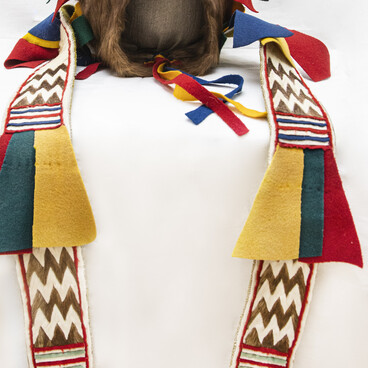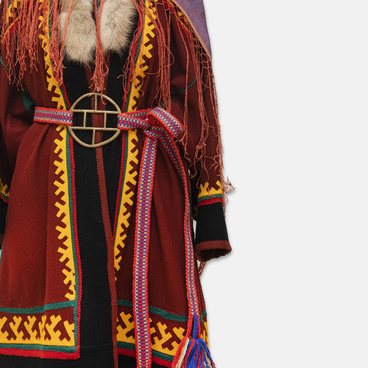Reindeer hides are the main clothing material used by the indigenous peoples of the North. They vary depending on the deer’s age, fur density, season, quality, and color, and each type is used for specific parts of clothing.
“Vyporotok” is the hide of an unborn deer that died due to a miscarriage, or its mother having died or being slaughtered. It has weak and short fur, which is most often used as lining for hats and mittens.
The hide of a young deer up to one month old is called “pyzhik” in the European North, and “peshka” in Western Siberia. Young deer are not slaughtered for their hide. Instead, the Nenets only use the hide of young deer that died accidentally during spring frosts and snowstorms. Its soft fur differs greatly from that of an adult reindeer. It is used to sew hats, mittens, and other small items.
The hide of a young deer up to three months old, obtained in late July or August, is called “nebluj”. It is particularly valued because of its short pile. It is used to make outerwear, hats, and mittens. It is usually dark on the back and light on the sides and neck.
The hide of a six-month-old deer, obtained in autumn, is also considered valuable. It has a thick, dense pile and is used for women’s outerwear. The hide obtained from an adult deer in winter has a long and dense pile, but its value is lower due to the pile tearing and falling out, as well as defects caused by warbles.
Such pelts are used to sew lower-quality clothing, sleeping bags, fur-lined slippers, and mats. They are also used as bedding inside the chum and on cargo sleds. Fur stockings are sewn from trimmed low-quality hides. The material is also used for making coarse suede.
The hide from the deer’s forehead is called “lobash”. It is used to sew men’s summer shoes and bags. The hide from the lower part of the leg, near the hoof, is called “brush”. Because it has a stiff and coarse pile, and snow does not stick to it, it is used to line the soles of winter shoes.
The part of the hide that is especially valued in the North is the “kamus” — hide from the lower legs of an adult reindeer. It is smooth and shiny. Kamus is not only beautiful but also very durable. It is used for sewing shoes and mittens and for decorating large items with mosaic patterns.



